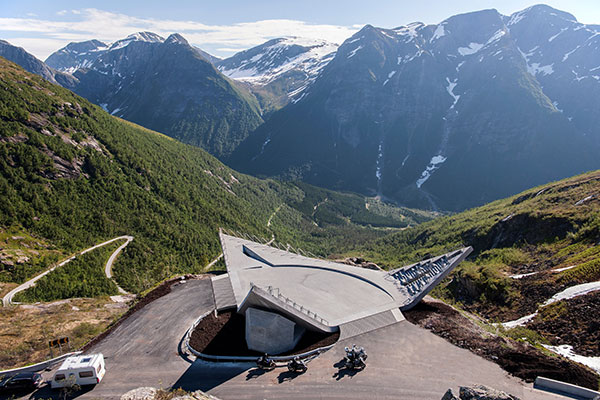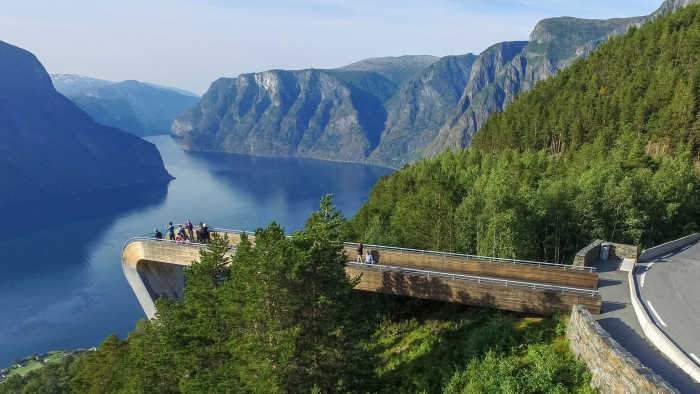Perilous picnic spots: Norway takes roadside stops to a new level

Simply sign up to the Life & Arts myFT Digest -- delivered directly to your inbox.
By 2023 Norway will have spent almost NKr3.5bn ($425m) on picnic spots — 250 of them, along 2,000km of road. They offer far more than the odd bench — they are architectural gems, gravity-defying feats of engineering. They make your feet tingle, your jaw drop, your carsickness worse and the average motorway service station seem a distant enemy.
The National Tourist Routes were an initiative set up in 1994 by the Norwegian Public Roads Administration to identify the country’s key scenic roads and pepper them with spectacular architectural pit stops.
Combining roads, tourism, architecture and art, it is a bid to encourage travel to all parts of Norway, boost local economies and celebrate the diversity of the landscape — akin to the scenic byways in the US or France’s routes des vins but with architecture centre stage.
The brief for the architects is basic and practical: provide a picnic spot, viewing point, parking, waste facilities and toilets, and ensure the shelter endures against the elements and is low maintenance — but make it bold, unique and innovative.
Utsikten (The View) by Norwegian practice Code opened in June this year, living up to its name. Overlooking a mountain valley in the west of Norway, it resembles a giant (850 sq metre by 80cm thick) concrete picnic blanket turned up at the edges to provide seating above, with shelter and facilities beneath. The architects and engineers took up the challenge of a site with no electricity, unpredictable weather and limited access for construction work. They first built a full-scale version of the project out of wire, craning it in to test its positioning. “The starting point was the place itself,” says Eivind Nygaard of Code. “The ambition was to create one single object that could embrace all aspects of the stopover for visitors.”

Code is just one of 50 architecture and engineering firms working on similar projects across Norway. Rather than shipping in foreign talent, the teams are almost exclusively Norwegian, young and new, old and established. The National Tourist Routes project is an incubator for new Norwegian architecture, sponsored by the public sector. It challenges established traditions and strategically invests in pushing the boundaries of Norway’s architectural output. “The tourist route projects have become a typology in themselves — where boldness, sensitivity and craftsmanship are important characteristics,” says Code.
No project is the same — in location, form or architecture. All offer something unique to their position, from Arctic birdwatching hides (Birding Varanger designed by Biotope), wind shelters (Torvdalshalsen by 70°N arkitektur), salmon fishing points (Snefjord by Pushak) and ferry ports (Eggum by Snohetta) to more modest interventions such as a concrete staircase to the water (Hellaga by Nordplan and Landskapsfabrikken).

Norway knows how to do roads: it has the world’s longest tunnel (24.5km), the deepest undersea road (at a depth of 287 metres) and one of the most treacherous (11 consecutive hairpin bends). Roads bridge fiords, traverse waterfalls, skirt glaciers and burrow through mountains. They are dramatic and their architectural intersections follow suit.

The Stegastein viewpoint, designed by Todd Saunders and Tommie Wilhelmsen, is effectively a timber diving board, four metres by 30 metres, projecting beyond the edge of a cliff, 650 metres above Aurlandsfjord, an arm of Norway’s deepest fiord. As you approach the end, the board falls away, plunging down to the water below, with only a glass screen stopping you and your wobbly legs from going with it.

Are the projects all a bit theme park? No. Often they are used to convey Norwegian culture, history and memory. The latest project to open is Allmannajuvet by the (only non-Norwegian) architect Peter Zumthor. Here, three structures sit on the edge of disused zinc mines in Sauda, south-west Norway. One clings to the cliff wall while the other two sit on wooden stilts over the sheer edge. They are simple wooden structures with zinc roofs, housing a museum about Norwegian culture and 19th-century zinc mining. Similarly, on Vardo island — at Norway’s most north-easterly point — the Steilneset Memorial, by Zumthor and Louise Bourgeois, is both a museum and art installation in memory of the victims burnt at the stake in the 1621 Finnmark witch trials.

Sometimes the projects serve a local purpose, as is the case with the corten steel Hose bridge by Rintala Eggertsson Architects. This connects the village of Sand in the south-west of the country to the woodland on the other side of the Suldalslagen river. It is a perforated metal box with an awesome interplay of light and sound — the water rushing beneath the simple steel structure can be heard and glimpsed.

To go on a journey in Norway means to enjoy the journey itself. So much so that the trend is to take a home with you, in the Scandinavian tradition of the motorhome, enhanced by liberal laws allowing wild camping freedom.
Journeys can be planned according to key rest stops: the Grunnfor bicycle shelter, designed by 70˚N arkitektur, along a coastal cycle route is a modest timber lookout with nothing more than space to park your bike, prepare food in the small kitchen and climb the stairs to enjoy 360-degree views from the glazed upper deck.

As I discovered this summer, journeys can also be extended by lengthy detours in a quest for architectural refreshment. An extreme excursion might be to Selvika Bay, for example, a barren, remote environment in the far north with little sign of human intervention save the few remnants of deserted Sami settlements. Architect Reiulf Ramstad has cast a meandering concrete walkway down to a beachside firepit and outdoor kitchen. Here you can catch your fish, swim in the sea, sit back against the concrete cocoon and gaze out at the Norwegian Sea before getting back in the car.
The projects are intended to strengthen rural life by boosting economies, encourage tourism in the most remote corners and reaffirm the population’s love of their own land. But they are not always loved by locals. Although roads and amenities have been improved, they have brought crowds, traffic and urban materials (steel, glass, concrete) into the rural environment. That said, there is no doubting the high quality of each project. And less than 10 years from completion, there are no signs of ambitions diluting or corners being cut.

In the 18th century, English picturesque landscaping mastered the use of undulating paths and panoramas, dotted with architectural fragments: pyramids, ruins, temples, bridges, caves and tea houses. Norway has done the same but on a much larger scale, choreographing all manner of tools and framing devices, such as a panoramic platform (Trollstigen by Reiulf Ramstad) or sheltered cave (Vedahaugane by LJB and artist Mark Dion). Where a landscape was once a sea of rolling mountains and sheer fiords, it is now punctuated by places, and approached dynamically by winding roads.
Norway is making a colossal investment in its architecture through this project. Not just through infrastructure, precise engineering and immaculate execution, but in its committed vision of architecture’s importance. It makes picnics elsewhere seem very stale indeed.
Harriet Saddington is an architect based in London
Photographs: Jiri Havran; Jarle Wæhler/Statens vegvesen; Anne Olsen-Ryum for Statens vegvesen; Kjetil Rolseth; Bjarne Riesto; Jarle Lunde; Tormod Amundsen/biotope.no
Comments